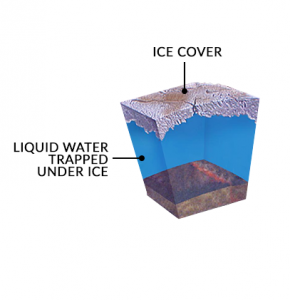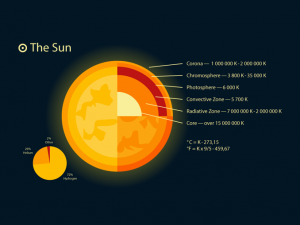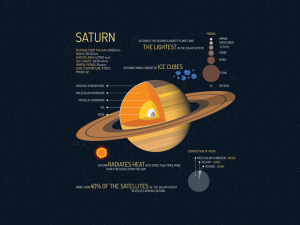10 Colossal Facts About the Gas Giant Planet Jupiter [Infographic]

“Jupiter is colossal in size. It’s the largest planet in our solar system. Nearly 1000 Earths can fit in Jupiter.”
It’s so big that if you combined all the other planets, moons, and asteroids in our solar system in a ball, it still wouldn’t be half the size of Jupiter.
In fact, if Jupiter was 50 times larger than it is now, it would be a star on its own. And if you combined all the planets in the solar system, it still wouldn’t be as big as Jupiter. Not even close.
Other than its tremendous size, let’s explore the planet Jupiter with this list of 10 facts about Jupiter.
1. Jupiter is extremely windy

Jupiter spins at an incredible pace. The velocity at Jupiter’s equator is about 28,000 miles per hour, compared to Earth’s 1000 mph.
This means that one day on Jupiter takes a bit less than 10 hours. Because of its fast rotation and heaping size, the Coriolis effect is extraordinary in size.
Jupiter’s weather is so extreme that we can see it from space. For example, astronomers have observed an everlasting hurricane ever since we’ve first seen it.
We see this enormous cyclone as a red spot on it because of the Coriolis effect. Also, the Coriolis effect gives Jupiter its banded appearance.
2. It has the biggest aurora borealis in the solar system

The Aurora Borealis isn’t unique to Earth. Jupiter has a similar display of lights but of much greater size in comparison.
Electrically charged particles in the magnetosphere and solar radiation from the sun create a magnificent display of aurora borealis on Earth.
Similarly, solar storms cause huge auroras on Jupiter. But they glow much brighter than Earth because Jupiter’s tremendous size gives it more electrical potential.
3. Jupiter has 79 moons

It’s believed that Jupiter has 79 moons. Only 53 of the moons have names and 26 are awaiting for names. Four of Jupiter’s large moons are particularly exciting because of their interesting geology:
- Ganymede
- Callisto
- Io
- Europa
They were all formed with rock and metal like terrestrial planets but also water, ammonia, and methane. One of them even has the potential to harbor life beneath its ice-covered crust.
As of 2018, astronomers discovered 12 new moons increasing the total to 91. This includes one oddball moon that circles Jupiter in the opposite direction as the others.
4. Its moon “Io” is yellow because it’s filled with sulfur

Jupiter’s moon “Io” is the most volcanic place in our solar system. It’s constantly erupting liquid basalt and sulfur making it the most geologically active body in the solar system.
Io is best known for its yellow appearance. This is because of all the volcanic activity present on it. It’s not only color but its scent would be absolutely pungent. If you were to set foot on Io, the smell would be unbearable due to the sulfur.
It’s because you have tidal heating from Jupiter stretching and compressing creating molten rock.
5. Life may exist on its moon “Europa” because it has liquid water

We never expect life to exist on gas giants because they don’t have a surface. In addition, they are mostly just hydrogen and helium.
Europa is made of iron rock. It has a saltwater ocean beneath a thin frozen icy crust. Its water level is about 100 km thick and its ice layer is maybe about 10 to 30 km.
When the ice crust layer cracks, water fills the cracks. It’s the heat that drives this process from the tidal forces of Jupiter.
Because Europa has liquid water at its surface, it’s one of the only places in the solar system where life could possibly exist.
6. Jupiter’s moon “Ganymede” is the largest planetary moon
Ganymede is so large that it’s the 9th largest object in our solar system. In fact, it’s larger than both Mercury and Pluto.
So if Ganymede orbited the sun, that would make it a planet of its own. Ganymede is made of rock and mantle with an icy crust. The crust on Ganymede is old.
Ganymede is the largest moon in the solar system and is even larger than the planet Mercury, known for its unique magnetic field and diverse surface features. It has old impact craters with an induced magnetic field.
7. Callisto is the second-largest planetary moon on Jupiter
Callisto is about the size of the planet Mercury. It’s the most heavily cratered object in our solar system.
It’s the second-largest moon of Jupiter and is the third-largest moon in our solar system. It’s composed of half rock and ice. There’s potential that it could have deep liquid oceans.
Overall, it doesn’t have significant tidal heating and is less affected by Jupiter’s magnetosphere.
8. Jupiter doesn’t have a solid surface

The reality is that Jupiter is a raging ball of hydrogen and helium without a solid surface. Out of all the planets in the solar system, Jupiter formed first pulling in available gasses.
For Earth, any hydrogen and helium atom fly out of space because we’re not big enough to hold onto it. But bigger planets like Jupiter, Saturn, and Uranus are able to hold onto hydrogen and helium.
“Unlike Earth, Jupiter had held onto its original composition. This is because Jupiter’s gravity is large enough to hold onto light gases like hydrogen and helium. This way, we can get a sneak peek of our early solar system.”
9. It competes with the sun in the biggest tug-of-war in the solar system

When you have two large bodies like Jupiter and the sun in the solar system, you have two large opposing forces of gravity pulling on each other.
This gravity tug-of-war between the two behemoths puts Mercury, Venus, Mars, Earth and an asteroid belt smack dab in the middle.
Neither side wins so all these objects remain in between.
The distance between Jupiter and the sun is about 5.2 AU. That’s about 778 million kilometers of tug-of-war.
10. Quick facts about Jupiter
Finally, NASA has a list of facts about Jupiter. Here are some other quick facts about the gas giant.
- Jupiter goes through one day in only 10 hours.
- It has an orbital period of about 12 years.
- The length of a day on Jupiter is 9 hours and 56 minutes.
- The distance from the sun to Jupiter is about 778,500,000 km.
- Its surface area is about 61.42 km2.
- In terms of mass, gas giants like Jupiter dwarfs Earth.
- The colossal heavyweight Jupiter radius is nearly 70,000 km compared to Earth’s measly 6,371 km.
- It’s the 5th planet from the sun.
- The Galileo mission was the first to orbit Jupiter.
- Juno spacecraft orbits Jupiter
- The name Jupiter originates from Roman and Greek mythology. Jupiter created clouds to hide himself. It was Juno, his wife, who could veer through the clouds to see what Jupiter was up to.
- Galileo viewed Jupiter with his telescope invention more than 400 years ago.
- Jupiter is covered by clouds of gas which are poisonous to us.















I can’t tell you 100% if it’s Jupiter or not. When I look up at the sky at night and don’t know the star or constellation, I use the SkyView app. Basically, you point it up at the sky and it shows you in real-time what it is. This includes all the planets in our solar system.
For satellites, there are thousands that orbit the Earth. You can also find real-time satellite maps. I haven’t found one as good as the SkyView app, where it orients itself. If you do try it out, let me know which one is best for tracking satellites.
J’habite à Québec, la façade de mon appartement est à l’ouest, dans la même direction que l’autoroute Robert Bourassa, lorsque je me réveille la nuit si je regarde le ciel j’aperçois quelque chose qui brille dans le ciel et qui ne semble pas être une étoile, ça m’intrigue beaucoup, des personnes m’ont dit que c’est la station spatiale, d’autres que c’est Jupiter, comment faire pour savoir avec certitude ce que c’est; ce soir vers 21:30 hres je l’aperçu davantage au sud donc cette chose se déplace du sud au nord.
Aidez-moi svp
Merci
Above the Giant Storm Ley forces exist around Jupiter, and below the storm area noxious lines run around the planet. See Alf Riggs on the Internet Noxious Lines, so forces both on planet Earth and Jupiter must be a cosmic thing.